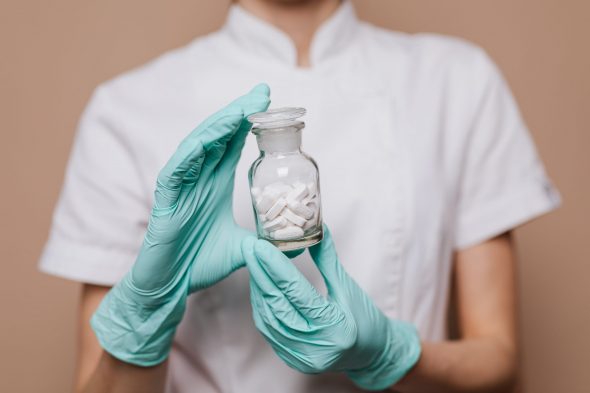COVID-19 pharmacological results disappointing

Cheryl Guttman Krader
Published: Wednesday, May 20, 2020
 Photo by Karolina Grabowska from Pexels[/caption]
Hydroxychloroquine and lopinavir-ritonavir, a combination of two antiretroviral drugs, are among the many pharmacologic agents being looked at as treatments for COVID-19. As reported in articles published online in the New England Journal of Medicine on May 7, studies investigating the potential efficacy of these interventions failed to meet their primary endpoint.
The antiretroviral drug combination was evaluated in a randomised, controlled, open-label trial conducted in Wuhan, China by Bin Cao, MD, et al. It enrolled 199 hospitalised, severely ill adults who received a 14-day course of lopinavir-ritonavir with standard care or standard care alone. Median time between symptom onset and randomisation to study treatment was 13 days.
The primary endpoint analysis found no difference between the treated and control groups in the time to clinical improvement (median 16 days for both). There was also no difference between groups in the 28-day mortality rate. In addition, the antiretroviral drug combination had no benefit for reducing viral RNA loads or duration of viral RNA detectability.
Adverse events, mostly gastrointestinal-related, led to early discontinuation of lopinavir-ritonavir in 14% of patients.
The efficacy of hydroxychloroquine was investigated in a large, American, observational study reported by Joshua Geleris, MD, et al. After excluding patients who were intubated, died, or discharged within 24 hours after presenting to the emergency department, it analysed data for 1,376 consecutive patients admitted for care at a single large medical centre in New York City, New York.
Of the 1,376 patients, 811 (59%) received hydroxychloroquine. The treatment was started within 24 hours after presentation in 45.8% of patients and within 48 hours in 85.9% of patients, and it was given for a median of five days.
Comparing patients treated with hydroxychloroquine and untreated patients using a multivariable Cox model analysis with inverse probability weighting from a propensity score to control for confounders, the hazard ratio (95% confidence interval) for the composite primary endpoint of intubation or death was 1.04 (0.82 to 1.32). The outcomes were similar in multiple sensitivity analyses.
The authors of the study stated that considering the study’s observational design and the 95% confidence interval for the hazard ratio, the results should not be interpreted to either rule out benefit or harm of hydroxychloroquine. They concluded, however, that the findings do not support the use of hydroxychloroquine outside the context of a randomised clinical trial.
Photo by Karolina Grabowska from Pexels[/caption]
Hydroxychloroquine and lopinavir-ritonavir, a combination of two antiretroviral drugs, are among the many pharmacologic agents being looked at as treatments for COVID-19. As reported in articles published online in the New England Journal of Medicine on May 7, studies investigating the potential efficacy of these interventions failed to meet their primary endpoint.
The antiretroviral drug combination was evaluated in a randomised, controlled, open-label trial conducted in Wuhan, China by Bin Cao, MD, et al. It enrolled 199 hospitalised, severely ill adults who received a 14-day course of lopinavir-ritonavir with standard care or standard care alone. Median time between symptom onset and randomisation to study treatment was 13 days.
The primary endpoint analysis found no difference between the treated and control groups in the time to clinical improvement (median 16 days for both). There was also no difference between groups in the 28-day mortality rate. In addition, the antiretroviral drug combination had no benefit for reducing viral RNA loads or duration of viral RNA detectability.
Adverse events, mostly gastrointestinal-related, led to early discontinuation of lopinavir-ritonavir in 14% of patients.
The efficacy of hydroxychloroquine was investigated in a large, American, observational study reported by Joshua Geleris, MD, et al. After excluding patients who were intubated, died, or discharged within 24 hours after presenting to the emergency department, it analysed data for 1,376 consecutive patients admitted for care at a single large medical centre in New York City, New York.
Of the 1,376 patients, 811 (59%) received hydroxychloroquine. The treatment was started within 24 hours after presentation in 45.8% of patients and within 48 hours in 85.9% of patients, and it was given for a median of five days.
Comparing patients treated with hydroxychloroquine and untreated patients using a multivariable Cox model analysis with inverse probability weighting from a propensity score to control for confounders, the hazard ratio (95% confidence interval) for the composite primary endpoint of intubation or death was 1.04 (0.82 to 1.32). The outcomes were similar in multiple sensitivity analyses.
The authors of the study stated that considering the study’s observational design and the 95% confidence interval for the hazard ratio, the results should not be interpreted to either rule out benefit or harm of hydroxychloroquine. They concluded, however, that the findings do not support the use of hydroxychloroquine outside the context of a randomised clinical trial.